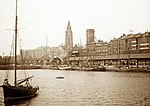Royal Liver Building

The Royal Liver Building is a Grade I listed building in Liverpool, England. It is located at the Pier Head and along with the neighbouring Cunard Building and Port of Liverpool Building is one of Liverpool's Three Graces, which line the city's waterfront. It was also part of Liverpool's formerly UNESCO-designated World Heritage Maritime Mercantile City. Opened in 1911, the building was the purpose-built home of the Royal Liver Assurance group, which had been set up in the city in 1850 to provide locals with assistance related to losing a wage-earning relative. One of the first buildings in the world to be built using reinforced concrete, the Royal Liver Building stands at 98.2 m (322 ft) tall to the top of the spires, 103.7 metres (340feet) to the top of the birds and 50.9 m (167 ft) to the main roof. The Royal Liver Building is one of the most recognisable landmarks in the city of Liverpool with its two fabled Liver Birds which watch over the city and the sea. Legend has it that if these two birds were to fly away, the city would cease to exist. The Liver Birds are 5.5 metres,18 feet high. Their added height gives the Royal Liver Building an overall height of 103.7 metres, 340 feet. A building of skyscraper proportion, and once one of the tallest buildings in the country, the Royal Liver Building is currently the 4th tallest building in Liverpool.
Excerpt from the Wikipedia article Royal Liver Building (License: CC BY-SA 3.0, Authors, Images).Royal Liver Building
Saint Nicholas Place, Liverpool Vauxhall
Geographical coordinates (GPS) Address External links Nearby Places Show on map
Geographical coordinates (GPS)
| Latitude | Longitude |
|---|---|
| N 53.4058 ° | E -2.9958 ° |
Address
Royal Liver Building
Saint Nicholas Place
L3 1HU Liverpool, Vauxhall
England, United Kingdom
Open on Google Maps









